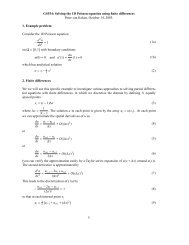Quantitative paleoenvironmental and paleoclimatic reconstruction ...
Quantitative paleoenvironmental and paleoclimatic reconstruction ...
Quantitative paleoenvironmental and paleoclimatic reconstruction ...
You also want an ePaper? Increase the reach of your titles
YUMPU automatically turns print PDFs into web optimized ePapers that Google loves.
ARTICLE IN PRESS<br />
28 N.D. Sheldon, N.J. Tabor / Earth-Science Reviews xxx (2009) xxx–xxx<br />
Fig. 17. Photomicrographs of paleosol carbonates. Mi=micrite, Sp=Sparite, MS =microspar (A) Nearly pure microcrystalline calcite (micrite; gray areas) that occludes mudstone<br />
from the matrix (red areas) in an Upper Triassic (Carnian) paleosol carbonate nodule of the Ischigualasto fm., Argentina. The area shown is appropriate for sampling, <strong>and</strong><br />
determination of δ 18 O <strong>and</strong> δ 13 C values, in order to approximate environmental conditions during pedogenesis. Field of view is 2 mm. (B) Nearly pure micrite from a cross-section of a<br />
vertically oriented rhizolith in a paleosol from the Middle Permian Quanzijie fm, Xinjiang Province, Northwest China. The area shown is appropriate for sampling, <strong>and</strong> determination<br />
of δ 18 O <strong>and</strong> δ 13 C values, in order to approximate environmental conditions during pedogenesis. The red areas are colored by stain from potassium ferricyanide, which indicates lowmagnesium<br />
calcite. The light gray areas are gypsum. Scale bar is 1 mm. (C) Domains of (1) micrite, (2) veins of sparry calcite, <strong>and</strong> (3) mixed micrite, microspar <strong>and</strong> Fe-oxide in a<br />
paleosol nodule from the Late Triassic (Carnian) Ischigualasto fm., Argentina. δ 18 O <strong>and</strong> δ 13 C values from domains of sparry calcite <strong>and</strong> mixed microspar <strong>and</strong> micrite are inappropriate,<br />
whereas δ 18 O <strong>and</strong> δ 13 C values from domains of micrite are appropriate, for sampling <strong>and</strong> measurement of oxygen isotope values in order to approximate environmental conditions<br />
during pedogenesis. Field of view is 4 mm. (D) Clotted micrite (dark areas) that is finely intergrown with microspar (light areas) from a paleosol nodule in Cretaceous<br />
(Kimmeridgian) strata of the Democratic Republic of Congo. Dark areas are stained by Fe-oxides. Field of view is 0.5 mm. While the areas of clotted micrite are appropriate for oxygen<br />
<strong>and</strong> carbon isotope analysis in order to approximate pedogenic conditions, very fine intergrowth of microspar <strong>and</strong> micrite makes sampling of the appropriate phase very challenging,<br />
<strong>and</strong> likely only feasible via a computer-assisted drill system. (E) Lamellar micrite intercalated with sparry calcite from a horizontal rhizolith in the Middle Permian Moradi fm., Niger.<br />
Field of view is 2 mm. While areas of micritic calcite are appropriate for sampling <strong>and</strong> oxygen <strong>and</strong> carbon isotope analysis in order to interpret environmental conditions during<br />
pedogenesis, domains of micrite are relatively narrow, <strong>and</strong> divided by complex networks of sparry <strong>and</strong> microspar cements. Samples such as this should be avoided for isotopic<br />
analysis, or employ a computer-assisted drill system. Sampling. (F) Sphaerosiderites in claystone matrix from an Upper Oligocene paleosol in Chilga Woreda, northwestern Ethiopia.<br />
Siderite spherules such as these are appropriate for carbon <strong>and</strong> oxygen isotope analysis in order to interpret environemtnal conditions during pedogenesis. (For interpretation of the<br />
references to colour in this figure legend, the reader is referred to the web version of this article.)<br />
paleosols from the mid-continent, U.S.A., Fox <strong>and</strong> Koch (2004)<br />
suggested that long-term trends in calcite δ 18 O values appear to track<br />
changes in rainfall δ 18 O values related global-scale paleoclimate<br />
factors, where the most positive δ 18 O values occur in strata from the<br />
mid-Miocene climatic optimum, <strong>and</strong> a stepped trend toward more<br />
negative δ 18 O values occurs in post mid-Miocene samples during the<br />
interval of Late Cenozoic cooling, <strong>and</strong> northern hemisphere glaciation.<br />
Levin <strong>and</strong> others (2004) observed a positive ~5.5‰ shift in δ 18 O<br />
values of paleosol calcite occurring in ~4.5 Ma strata of southern<br />
Ethiopia which they attributed to climatic change possibly including<br />
closure of the Indonesian seaway, long-term uplift of the East African<br />
highl<strong>and</strong>s, <strong>and</strong> aridification of eastern Africa. Koch et al. (2003) noted<br />
a small positive δ 18 O shift of approximately 1‰ in the Bighorn Basin,<br />
Wyoming, U.S.A., that is synchronous with the Paleocene–Eocene<br />
Please cite this article as: Sheldon, N.D., Tabor, N.J., <strong>Quantitative</strong> <strong>paleoenvironmental</strong> <strong>and</strong> <strong>paleoclimatic</strong> <strong>reconstruction</strong> using paleosols, Earth-<br />
Science Reviews (2009), doi:10.1016/j.earscirev.2009.03.004















